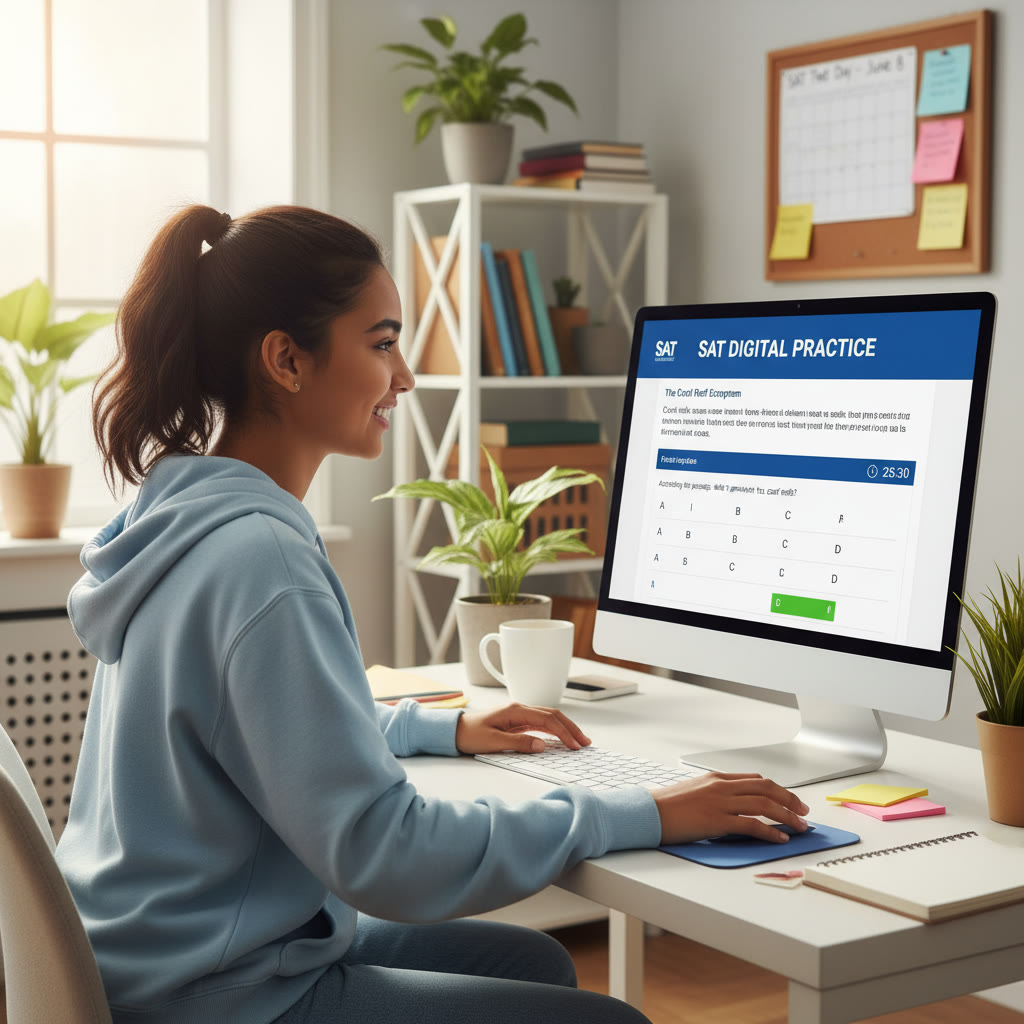The Rise of Adaptive Testing: A Quiet Revolution in Exam Rooms
If you walked into a test center a decade ago and then walked into one today, you might not notice much at first glance. But behind the screens, the way exams find out what you know has been quietly changing. Adaptive testing is no longer an obscure research topic. It has moved into real-world exams, influenced college admissions testing, and reshaped how students prepare for high-stakes assessments like the SAT.
This piece is written for you—the student pacing your study calendar, balancing practice tests and sleep, and wondering how the world of testing affects your chances. We’ll demystify adaptive testing, explore how it changes the student experience, and offer practical strategies you can use right away. Along the way I’ll note how targeted support, such as Sparkl’s personalized tutoring with 1-on-1 guidance, tailored study plans, expert tutors, and AI-driven insights, can fit naturally into this new landscape.
What Is Adaptive Testing? Two Flavors You Should Know
Adaptive testing is an approach where the test adjusts to the test taker’s ability in real time or between sections. Instead of every student receiving the same set of questions in the same order, adaptive tests use responses to guide which questions appear next. That makes the test more efficient and often more accurate.
Item-level Computer-Adaptive Tests (CAT)
In an item-level CAT, each question you answer influences the next question. If you answer correctly, the algorithm tends to present a slightly harder item. If you miss it, the next item may be a bit easier. Tests like the GMAT have used this model for years. The power of item-level CAT is precision: it homes in on the level that matches your ability quickly.
Multi-stage Adaptive Tests (MST) or Section-Adaptive Tests
Section-adaptive designs are more gradual. A test is divided into modules or sections. Your performance in the first module determines which module you receive next. The digital SAT, for example, uses a section-adaptive approach: early performance influences the difficulty of later sections, but each section still contains a set of preselected items. This hybrid approach balances adaptability with practical concerns like content security and fairness.
Why Adaptive Testing Has Grown Quickly
Several forces have converged to accelerate the rise of adaptive testing.
- Technology: Widespread computer delivery makes adaptive algorithms practical in real testing environments.
- Efficiency: Adaptive tests can reach the same measurement precision with fewer items, making test sessions shorter while preserving accuracy.
- Fairness and measurement: Well-designed adaptive tests can produce more precise estimates of ability for both high- and low-performing students.
- Demand for personalization: Education increasingly values tailored learning experiences. Adaptive testing fits naturally with that trend, providing a more individualized measurement of skills.
How Adaptive Testing Affects Students: The Big Picture
The adaptive approach changes more than just the order of questions. It impacts preparation strategy, test-day psychology, and even how tutors and teachers structure practice. Here are the major effects students experience.
1. A More Personalized Challenge
In adaptive tests you’re not fighting the same questions as everyone else. If you’re strong in algebra but shaky in geometry, an adaptive test will probe your algebra skills with tougher items, zooming in on your true level. That’s good: the test is diagnosing your strengths and weaknesses more precisely. It also means a single lucky guess or unlucky typo may be relatively more consequential early on, because early performance steers the path forward.
2. Different Study Priorities
With traditional fixed-form tests, a reasonable strategy was to identify frequently tested item types and drill them. In adaptive environments, broad conceptual mastery becomes more valuable. You’re less likely to be rescued by repetitive exposure to a single item type, because the algorithm quickly adjusts. That doesn’t mean drilling is worthless—it means you should diversify practice, deepen conceptual understanding, and learn how to handle variety under time pressure.
3. Pressure and Pacing Changes
Because adaptive systems react to early answers, students often feel the first few items are make-or-break. That perception can increase anxiety. The reality is gentler: algorithms look for an overall pattern, not a single right or wrong answer. Still, early pacing strategies and calm routines matter more than ever.
4. Interface and Digital Fluency Matter
Many adaptive tests are digital. If you’re not used to reading passages and marking answers on a screen, you’ll spend mental energy on the interface rather than the question. Practicing with the same type of digital platform—timed, with the same navigation features—reduces friction and helps you conserve cognitive bandwidth for problem solving.
A Practical Comparison: Adaptive vs Traditional Tests
| Feature | Traditional Fixed Test | Adaptive Test |
|---|---|---|
| Question Order | Same for all test takers | Depends on your answers |
| Length | Often longer to cover a range of abilities | Often shorter due to efficiency |
| Measurement Precision | Good if many items | High, especially across ability levels |
| Preparation Focus | Familiarity with common item types and pacing | Broader conceptual mastery and adaptability |
| Test Experience | Predictable—same path for everyone | Personalized—less predictable |
| Impact of Early Questions | Lower—later questions still balance score | Higher—early performance influences later difficulty |
Real-World Scenarios: How Adaptivity Plays Out
Let’s make this concrete with two student stories.
Student A: The Fast Riser
Jamie has strong reasoning and good, consistent scores on practice. In an adaptive test, Jamie answers the early medium-difficulty questions correctly and the algorithm quickly presents harder questions. The result is a compressed path toward a high-precision estimate of Jamie’s ability. Jamie benefits because the test is efficiently gathering information about strengths at the top end.
Student B: The Recoverer
Riley wakes up nervous and stumbles on a couple of early questions. The adaptive system shifts to slightly easier questions. If Riley calms down and answers the next items correctly, the algorithm will adjust upward. Because adaptive systems look for patterns, middle-of-test recovery is possible—what matters is consistent ability detection, not a single mistake.
These examples show why it’s useful to practice mental resets and recovery strategies during practice. In adaptive tests you’re not locked into one trajectory forever; you have chances to demonstrate your true ability throughout.
Study Strategies for an Adaptive Test World
Preparation in the adaptive era is both familiar and different. Here are practical tactics that work.
1. Practice with Adaptive Simulators
Use platforms that mimic the adaptive behavior you’ll face. That includes realistic item difficulty progression and the same digital interface. If you’re preparing for the digital SAT, get comfortable reading long passages on a screen and managing question navigation under time pressure.
2. Build Conceptual Depth, Not Just Rote Routines
Because the algorithm will probe a variety of topics, aim to understand core concepts at a deeper level. When you can explain why an answer is right rather than just memorizing the steps, you’re better prepared to handle unexpected twists.
3. Work on Recovery Techniques
Train yourself to shake off mistakes quickly. Simple rituals help: a steady breath, a short physical adjustment, and a mental mantra like “One question at a time.” In practice tests, intentionally create small setbacks and practice returning to focused work.
4. Track Error Patterns, Not Just Scores
Adaptive tests and the analytics around them can show more nuanced patterns than raw scores. Look for recurring misconceptions rather than just a number. This is where tutoring shines—Sparkl’s personalized tutoring can translate these analytics into a tailored study plan and 1-on-1 guidance that targets exactly what you need to fix.
5. Simulate Test Conditions
Practice with timed sections, on the same type of device, and in a quiet environment. The fewer surprises you face on test day, the better you’ll perform when adaptivity starts nudging difficulty around.
Equity, Accessibility, and the Ethical Side of Adaptivity
Adaptive testing brings real benefits, but it also raises valid equity and fairness questions. A few to keep in mind:
- Device and connection disparities: If a test requires digital delivery at home, not all students have equal equipment or internet reliability.
- Algorithm transparency: Students and educators may want to understand how decisions are made. Clear guidelines about scoring and adaptive procedures help build trust.
- Item pool fairness: The quality and diversity of items in the pool matter. Biased or culturally narrow items can disadvantage some groups.
- Accommodations: Students with disabilities need reliable, tested accommodations that work with adaptive algorithms.
Awareness of these areas is important. Schools and testing organizations are actively working on solutions, and so are educators and tutors who can help students navigate the system fairly.
How Tutors and Personalized Programs Fit In
In an adaptive testing world, tutoring remains extremely valuable—but the role shifts. It’s less about memorizing predictable items and more about developing flexibility and precision. Here’s how tailored support helps:
- Targeted Remediation: Tutors identify exact misconceptions and give focused practice to close gaps.
- Strategy Coaching: Beyond content, good tutors teach pacing, recovery, and digital test navigation skills.
- Data-Driven Planning: Programs that leverage performance analytics can create efficient, personalized study plans. Sparkl’s personalized tutoring, for example, blends 1-on-1 guidance with tailored study plans and AI-driven insights to help students use practice data effectively.
- Confidence Building: Regular, supportive feedback helps reduce test anxiety—vital when early questions can feel more consequential.
Practical Checklist: What to Do in the Final Weeks
- Take at least two full adaptive-style practice tests under test-day conditions.
- Review error patterns and create targeted mini-sessions (30–45 minutes) for the top three weaknesses.
- Practice recovery routines—simulate getting a couple of early questions wrong and practice regaining focus.
- Check your device setup: battery, screen brightness, and familiar keyboard or on-screen controls.
- Sleep more than you study the night before. A rested brain handles adaptivity better than an exhausted one.
The Future: Where Adaptive Testing Might Take Us
Adaptive testing is likely to expand in both scope and sophistication. Expect to see:
- Better integration with formative assessments in classrooms, so adaptive technology guides learning before high-stakes testing.
- Smarter item pools that present richer, more authentic tasks rather than isolated multiple-choice questions.
- Improved fairness tools built into algorithms, designed to detect and reduce bias.
- Tighter links between adaptive diagnostics and personalized learning pathways, possibly driven by AI insights that identify gaps and recommend lessons.
Right now, companies and educators are experimenting with these ideas. For students, the immediate takeaway is simple: adaptivity rewards adaptability. If you can learn broadly, think flexibly, and recover quickly from setbacks, you’ll be well positioned for the new testing era.
Final Words: Adapt, Prepare, and Stay Calm
The rise of adaptive testing changes the terrain, but not the fundamentals. Deep understanding, consistent practice under realistic conditions, and emotional readiness remain the pillars of success. The tools and platforms around you may vary, but a reliable approach—practice deliberately, analyze errors, and refine strategies—will always pay off.
If you want help navigating this landscape, consider coaching that combines human expertise with data-driven planning. Personalized options like Sparkl’s tutoring blend 1-on-1 guidance, tailored study plans, expert tutors, and AI-driven insights to help you focus on what truly moves the needle. That kind of targeted support can be especially useful when adaptive algorithms are doing the diagnosing for you.


Quick Summary
Adaptive testing is spreading because it measures ability efficiently and personally. It changes how tests behave and how students should prepare: practice broadly, master concepts, simulate digital conditions, and rehearse recovery tactics. Tutors and personalized programs—especially those using data and human coaching—can accelerate that preparation by turning practice into meaningful improvement.
In the end, adaptivity is another tool. Use it wisely, prepare thoughtfully, and remember: tests measure a snapshot of your skills. With the right strategy and support, you can make that snapshot reflect the best version of what you know.













No Comments
Leave a comment Cancel